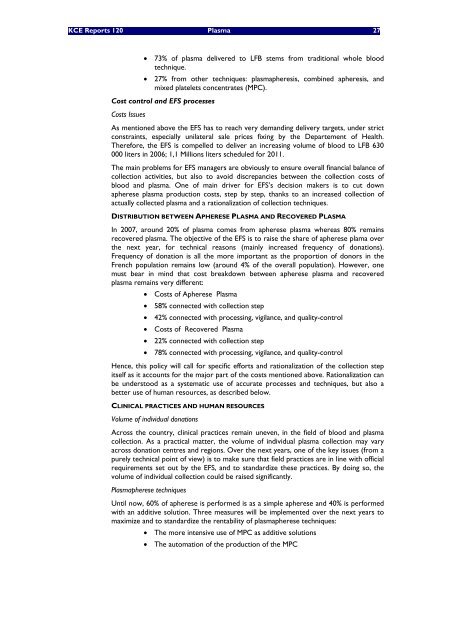The report is available in English with a French summary - KCE
The report is available in English with a French summary - KCE
The report is available in English with a French summary - KCE
Create successful ePaper yourself
Turn your PDF publications into a flip-book with our unique Google optimized e-Paper software.
<strong>KCE</strong> Reports 120 Plasma 27<br />
• 73% of plasma delivered to LFB stems from traditional whole blood<br />
technique.<br />
• 27% from other techniques: plasmapheres<strong>is</strong>, comb<strong>in</strong>ed apheres<strong>is</strong>, and<br />
mixed platelets concentrates (MPC).<br />
Cost control and EFS processes<br />
Costs Issues<br />
As mentioned above the EFS has to reach very demand<strong>in</strong>g delivery targets, under strict<br />
constra<strong>in</strong>ts, especially unilateral sale prices fix<strong>in</strong>g by the Departement of Health.<br />
<strong>The</strong>refore, the EFS <strong>is</strong> compelled to deliver an <strong>in</strong>creas<strong>in</strong>g volume of blood to LFB 630<br />
000 liters <strong>in</strong> 2006; 1,1 Millions liters scheduled for 2011.<br />
<strong>The</strong> ma<strong>in</strong> problems for EFS managers are obviously to ensure overall f<strong>in</strong>ancial balance of<br />
collection activities, but also to avoid d<strong>is</strong>crepancies between the collection costs of<br />
blood and plasma. One of ma<strong>in</strong> driver for EFS’s dec<strong>is</strong>ion makers <strong>is</strong> to cut down<br />
apherese plasma production costs, step by step, thanks to an <strong>in</strong>creased collection of<br />
actually collected plasma and a rationalization of collection techniques.<br />
DISTRIBUTION BETWEEN APHERESE PLASMA AND RECOVERED PLASMA<br />
In 2007, around 20% of plasma comes from apherese plasma whereas 80% rema<strong>in</strong>s<br />
recovered plasma. <strong>The</strong> objective of the EFS <strong>is</strong> to ra<strong>is</strong>e the share of apherese plama over<br />
the next year, for technical reasons (ma<strong>in</strong>ly <strong>in</strong>creased frequency of donations).<br />
Frequency of donation <strong>is</strong> all the more important as the proportion of donors <strong>in</strong> the<br />
<strong>French</strong> population rema<strong>in</strong>s low (around 4% of the overall population). However, one<br />
must bear <strong>in</strong> m<strong>in</strong>d that cost breakdown between apherese plasma and recovered<br />
plasma rema<strong>in</strong>s very different:<br />
• Costs of Apherese Plasma<br />
• 58% connected <strong>with</strong> collection step<br />
• 42% connected <strong>with</strong> process<strong>in</strong>g, vigilance, and quality-control<br />
• Costs of Recovered Plasma<br />
• 22% connected <strong>with</strong> collection step<br />
• 78% connected <strong>with</strong> process<strong>in</strong>g, vigilance, and quality-control<br />
Hence, th<strong>is</strong> policy will call for specific efforts and rationalization of the collection step<br />
itself as it accounts for the major part of the costs mentioned above. Rationalization can<br />
be understood as a systematic use of accurate processes and techniques, but also a<br />
better use of human resources, as described below.<br />
CLINICAL PRACTICES AND HUMAN RESOURCES<br />
Volume of <strong>in</strong>dividual donations<br />
Across the country, cl<strong>in</strong>ical practices rema<strong>in</strong> uneven, <strong>in</strong> the field of blood and plasma<br />
collection. As a practical matter, the volume of <strong>in</strong>dividual plasma collection may vary<br />
across donation centres and regions. Over the next years, one of the key <strong>is</strong>sues (from a<br />
purely technical po<strong>in</strong>t of view) <strong>is</strong> to make sure that field practices are <strong>in</strong> l<strong>in</strong>e <strong>with</strong> official<br />
requirements set out by the EFS, and to standardize these practices. By do<strong>in</strong>g so, the<br />
volume of <strong>in</strong>dividual collection could be ra<strong>is</strong>ed significantly.<br />
Plasmapherese techniques<br />
Until now, 60% of apherese <strong>is</strong> performed <strong>is</strong> as a simple apherese and 40% <strong>is</strong> performed<br />
<strong>with</strong> an additive solution. Three measures will be implemented over the next years to<br />
maximize and to standardize the rentability of plasmapherese techniques:<br />
• <strong>The</strong> more <strong>in</strong>tensive use of MPC as additive solutions<br />
• <strong>The</strong> automation of the production of the MPC

















